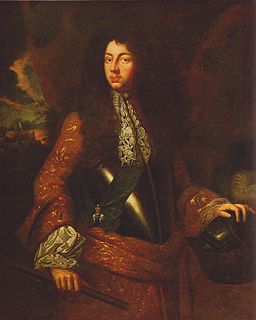
John Frederick, Margrave of Brandenburg-Ansbach succeeded his father Albert II as margrave of Ansbach in 1667. He married his second wife Princess Eleonore Erdmuthe of Saxe-Eisenach on 4 November 1681. Their daughter Wilhelmine Charlotte Caroline, Margravine of Brandenburg-Ansbach married George II of Great Britain before he became king.

Leopold I was the first King of the Belgians, reigning from 21 July 1831 until his death in 1865.

Leopold III was King of the Belgians from 23 February 1934 until his abdication on 16 July 1951. On the outbreak of World War II, Leopold tried to maintain Belgian neutrality, but after the German invasion in May 1940, he surrendered his country, earning him much hostility, both at home and abroad.

Baudouin, Dutch name Boudewijn, was King of the Belgians from 17 July 1951 until his death in 1993. He was the last Belgian king to be sovereign of the Congo.
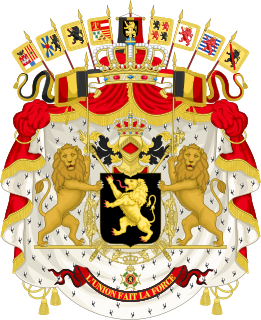
Belgium is a constitutional, hereditary, and popular monarchy. The monarch is titled king or queen of the Belgians and serves as the country's head of state. There have been seven kings since independence in 1830.

Francis I was the Duke of Lorraine and Bar (1729–1737), and later Grand Duke of Tuscany (1737–1765), who married Maria Theresa of Austria and became the last non-Habsburg Holy Roman Emperor (1745–1765) and Archduke of Austria (1740–1765). His wife effectively ruled Austria and the Holy Roman Empire. They were the founders of the Habsburg-Lorraine dynasty. The oldest surviving son of Leopold, Duke of Lorraine, Francis left the duchy for the deposed Polish king Stanisław Leszczyński in exchange for the Grand Duchy of Tuscany as one of the terms ending the War of the Polish Succession in 1738. The duchy and the ducal title to Lorraine and Bar passed to King Louis XV of France upon Leszczynski's death in 1766, though Francis and his successors retained the right to style themselves as dukes of Lorraine and Bar.

Charlotte of Belgium, known by the Spanish version of her name, Carlota, was by birth a Princess of Belgium and member of the House of Wettin in the branch of Saxe-Coburg and Gotha. As the wife of Archduke Maximilian of Austria, Viceroy of Lombardy–Venetia and later Emperor of Mexico, she became Archduchess of Austria and Empress consort of Mexico. She was daughter, granddaughter, sister, sister in-law, cousin and wife of reigning or deposed sovereigns throughout Europe and Mexico.
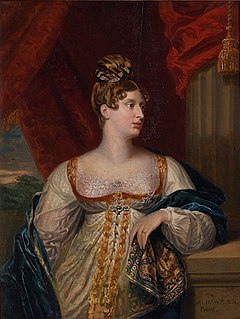
Princess Charlotte Augusta of Wales was the only child of George, Prince of Wales, and his wife, Caroline of Brunswick. Had she outlived both her grandfather George III and her father, she would have become Queen of the United Kingdom, but she died in childbirth at the age of 21, predeceasing them both.
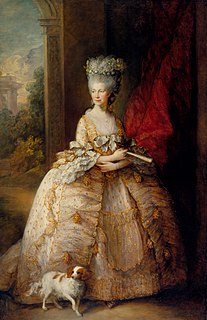
Charlotte of Mecklenburg-Strelitz was Queen of Great Britain and of Ireland as the wife of King George III from their marriage on 8 September 1761 until the union of the two kingdoms on 1 January 1801, after which she was Queen of the United Kingdom of Great Britain and Ireland until her death in 1818. As George's wife, she was also Electress of Hanover until becoming Queen of Hanover on 12 October 1814, when the electorate became a kingdom.

Prince Leopold, Duke of Albany, was the eighth child and youngest son of Queen Victoria and Prince Albert. Leopold was later created Duke of Albany, Earl of Clarence, and Baron Arklow. He had haemophilia, which contributed to his death following a fall at the age of 30.

Princess Victoria of Saxe-Coburg-Saalfeld, later Princess of Leiningen and subsequently Duchess of Kent and Strathearn, was a German princess and the mother of Queen Victoria of the United Kingdom. As the widow of Charles, Prince of Leiningen (1763–1814), from 1814 she served as regent of the Principality during the minority of her son from her first marriage, Carl, until her second wedding in 1818 to Prince Edward, fourth son of King George III.

Marie Henriette Anne of Austria was Queen of the Belgians as the wife of King Leopold II. The marriage was arranged against the will of both Marie Henriette and Leopold and became unhappy due to their dissimilarity, and after 1872 the couple lived separate lives, though they continued to appear together in public. Queen Marie Henriette was described as an energetic and intelligent horsewoman, foremost devoted to her animals. In 1895, she openly retired from public life and lived her last seven years in the city of Spa, where she became known as "The Queen of Spa".
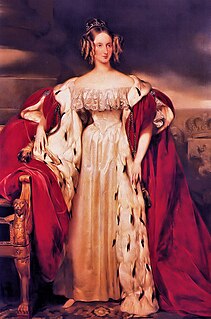
Louise-Marie Thérèse Charlotte Isabelle of Orléans was the first queen of the Belgians as the second wife of King Leopold I from their marriage on 9 August 1832 until her death in 1850. She was the second child and eldest daughter of the French king Louis Philippe I and his wife, Maria Amalia of the Two Sicilies. Louise rarely participated in public representation, but acted as the political adviser of her spouse. Her large correspondence is a valuable historical source of the period and has been published.

St George's Church, Esher is a Grade I listed Anglican church in Esher, Surrey, England. Built in the 16th century, it was Esher's parish church for 300 years, though later worshippers included Queen Victoria. However, by the mid-19th century the building was deemed too small for the growing population, and was replaced by Christ Church, built nearby on Esher Green in 1853/4. St George's was not therefore subjected to Victorian ‘improvements’, and its Tudor origins remain evident. It is now cared for by the Churches Conservation Trust.

The composer Wolfgang Amadeus Mozart was a Catholic, and the church played an important role in his life.
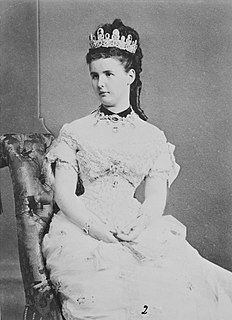
Princess Georgine Henriette Marie of Waldeck and Pyrmont was the third daughter of George Victor, Prince of Waldeck and Pyrmont and his wife, Princess Helena of Nassau, younger half-sister of Adolphe, Grand Duke of Luxembourg.

The First Gentleman is a 1948 British historical drama film directed by Alberto Cavalcanti, and starring Jean-Pierre Aumont, Joan Hopkins, and Cecil Parker. It portrays the relationships and marriage of George, Prince Regent and his tense dealings with other members of his family such as his only child Princess Charlotte and his younger brother Frederick, Duke of York. It was also released as Affairs of a Rogue.The film is based on a play, The First Gentleman by Norman Ginsbury, which was staged in London in 1945, starring Robert Morley as the Prince Regent and Wendy Hiller as Princess Charlotte.

St George's Chapel at Windsor Castle in England is a castle chapel built in the late-medieval Perpendicular Gothic style. It is both a Royal Peculiar and the Chapel of the Order of the Garter. St George's Chapel was founded in the 14th century by King Edward III and extensively enlarged in the late 15th century. It is located in the Lower Ward of the castle. The castle has belonged to the monarchy for almost 1000 years and was a principal residence of Elizabeth II before her death. The chapel has been the scene of many royal services, weddings and burials — in the 19th century, St George's Chapel and the nearby Frogmore Gardens superseded Westminster Abbey as the chosen burial place for the British royal family.The running of the chapel is the responsibility of the dean and canons of Windsor who make up the College of St. George. They are assisted by a Clerk, Verger and other staff. The Society of the Friends of St George's and Descendants of the Knights of the Garter, a registered charity, was established in 1931 to assist the college in maintaining the chapel.

The royal question was a major political crisis in Belgium that lasted from 1945 to 1951, coming to a head between March and August 1950. The question at stake surrounded whether King Leopold III could return to the country and resume his constitutional role amid allegations that his actions during World War II had been contrary to the provisions of the Belgian Constitution. It was eventually resolved by the abdication of Leopold in favour of his son Baudouin in 1951.
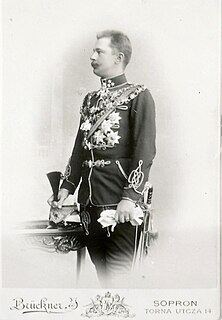
Prince Frederick of Schaumburg-Lippe was a German prince and head of the Náchod branch of the princely house of Schaumburg-Lippe.




















